SECTION 1 ANALYTICAL WRITING
TIME: 60 MINUTES—60 WRITING TASKS
Task 1: Analyze an Issue
30 MINUTES
Directions: In 30 minutes, compose an essay on the topic below. You may not write on any other topic.
The topic is presented in a one- to two-sentence quotation commenting on an issue of general concern. Your essay may support, refute, or qualify the views expressed in the quotation. Whatever you write, however, must be relevant to the issue under discussion, and you must support your viewpoint with reasons and examples derived from your studies and/or experience.
If you will be taking the computer-delivered test, write your essay using a word-processing program with its spelling and grammar checker turned off. If you will be taking the paper-delivered test, write your essay on lined paper using a #2 pencil.
Faculty members from various institutions will evaluate your essay, judging it on the basis of your skill in the following areas:
 Coverage of each of the elements in the task instructions
Coverage of each of the elements in the task instructions
 Analysis of the statement’s implications
Analysis of the statement’s implications
 Organization and articulation of your ideas
Organization and articulation of your ideas
 Use of relevant examples and arguments to support your case
Use of relevant examples and arguments to support your case
 Handling of the mechanics, grammar, and usage of standard written English
Handling of the mechanics, grammar, and usage of standard written English
ISSUE TASK
“We venerate loyalty—to our schools, employers, institutions, friends—as a virtue. Loyalty, however, can be at least as detrimental an influence as it can be a beneficial one.”
Compose an essay that identifies how greatly you concur (or differ) with the statement provided, describing in detail the rationale for your argument. As you build and provide evidence for your argument, include examples that demonstrate circumstances in which the statement could (or could not) be valid. Be sure to explain the impact these examples have on your argument.
Task 2: Analyze an Argument
30 MINUTES
Directions: In 30 minutes, prepare a critical analysis of an argument expressed in a short paragraph, following the specific task instructions provided. You may not offer an analysis of any other argument.
Be sure to support your analysis with evidence (reasons and/or examples) but do not present your personal views on the topic. Your job is to analyze the elements of an argument, not to support or contradict that argument.
If you will be taking the computer-delivered test, write your essay using a word-processing program with its spelling and grammar checker turned off. If you will be taking the paper-delivered test, write your essay on lined paper using a #2 pencil.
Faculty members from various institutions will evaluate your essay, judging it on the basis of your skill in the following areas:
 Coverage of each of the elements in the task instructions
Coverage of each of the elements in the task instructions
 Identification and assessment of the argument’s main elements
Identification and assessment of the argument’s main elements
 Organization and articulation of your thoughts
Organization and articulation of your thoughts
 Use of relevant examples and arguments to support your case
Use of relevant examples and arguments to support your case
 Handling of the mechanics, grammar, and usage of standard written English
Handling of the mechanics, grammar, and usage of standard written English
ARGUMENT TASK
The following appeared in a petition presented by Classen University students to the school’s administration.
“The purpose of higher education is to prepare students for the future, but Classen students ar at a serious disadvantage in the competition for post-college employment due to the University’s burdensome breadth requirements. Classen’s job placement rate is substantially lower than placement rates of many top-ranked schools. Classen students would be more attractive to employers if they had more time to take advanced courses in their specialty, rather than being required to spend fifteen percent of their time at Classen taking courses outside of their subject area. We demand, therefore, that the University abandon or drastically cut back on its breadth requirements.”
Compose an essay that identifies the questions that must be answered before reaching a conclusion about whether the prediction and the argument supporting it make sense. In writing your essay you should describe the impact that the answers to these questions would have on your assessment of the prediction.
SECTION 2 VERBAL REASONING
TIME: 30 MINUTES—20 QUESTIONS
Directions: For each of the following sentences, select the two answers of the six choices given that, when substituted in the sentence, both logically complete the sentence as a whole and create sentences that are equivalent to one another in meaning.
QUESTIONS 1–5
1. It seems ironic that the preacher’s sermon, intended to reconcile the feuding brothers, served only to ________ them further.
 intimidate
intimidate
 estrange
estrange
 avenge
avenge
 arbitrate
arbitrate
 commiserate
commiserate
 disaffect
disaffect
2. In recent years, the British seem to have become ________ Americanisms: even members of Parliament fall into baseball metaphors, although very few Britons understand the rules of the game.
 critical of
critical of
 indifferent to
indifferent to
 enamored of
enamored of
 aggrieved by
aggrieved by
 tired of
tired of
 hooked on
hooked on
3. The general was such a contrarian that, at times when it appeared that the only sane action would be to ________, he became all the more determined to fight to the bitter end.
 capitulate
capitulate
 remonstrate
remonstrate
 exonerate
exonerate
 submit
submit
 repeat
repeat
 resist
resist
4. Some critics of the administration maintained that it was ________ of the White House to describe its proposal to reduce welfare payments to single parents as “tough love”: the plan, in their opinion, while decidedly tough, was not loving at all.
 witty
witty
 accurate
accurate
 disingenuous
disingenuous
 diplomatic
diplomatic
 mendacious
mendacious
 salient
salient
5. A perfectionist is someone who feels ________ when he makes even the most minuscule of errors.
 vexation
vexation
 hostility
hostility
 indifference
indifference
 chagrin
chagrin
 condemnation
condemnation
 bafflement
bafflement
Directions: The next questions are based on the content of the following passage. Read the passage and then determine the best answer choice for each question. Base your choice on what this passage states directly or implies, not on any information you may have gained elsewhere.
For each of Questions 6–10, select one answer choice unless otherwise instructed.
QUESTIONS 6–10 ARE BASED ON THE FOLLOWING PASSAGE.
There can be no doubt that the emergence
of the Negro writer in the post-war period
stemmed, in part, from the fact that he
Line was inclined to exploit the opportunity to
(5) write about himself. It was more than that,
however. The movement that has variously
been called the “Harlem Renaissance,”
the “Black Renaissance,” and the “New
Negro Movement” was essentially a part of
(10) the growing interest of American literary
circles in the immediate and pressing social
and economic problems. This growing
interest coincided with two developments
in Negro life that fostered the growth of the
(15) New Negro Movement. These two factors,
the keener realization of injustice and the
improvement of the capacity for expression,
produced a crop of Negro writers who
constituted the “Harlem Renaissance.”
(20) The literature of the Harlem Renaissance
was, for the most part, the work of a race-
conscious group. Through poetry, prose, and
song, the writers cried out against social and
economic wrongs. They protested against
(25) segregation and lynching. They demanded
higher wages, shorter hours, and better
conditions of work. They stood for full social
equality and first-class citizenship. The new
vision of social and economic freedom that
(30) they had did not force them to embrace the
several foreign ideologies that sought to sink
their roots in some American groups during
the period.
The writers of the Harlem Renaissance,
(35) bitter and cynical as some of them were,
gave little attention to the propaganda of the
socialists and communists. The editors of the
Messenger ventured the opinion that the New
Negro was the “product of the same world-
(40) wide forces that have brought into being
the great liberal and radical movements
that are now seizing the reins of power in all
the civilized countries of the world.” Such
forces may have produced the New Negro,
(45) but the more articulate of the group did not
resort to advocating the type of political
action that would have subverted American
constitutional government. Indeed, the
writers of the Harlem Renaissance were
(50) not so much revolting against the system
as they were protesting its inefficient
operation. In this approach they proved as
characteristically American as any writers of
the period.
6. Which of the following is implied by the statement that the writers of the Harlem Renaissance “were not so much revolting against the system as they were protesting its inefficient operation” (lines 49–52)?
 Black writers played only a minor part in protesting the injustices of the period.
Black writers played only a minor part in protesting the injustices of the period.
 Left to itself, the system was certain to function efficiently.
Left to itself, the system was certain to function efficiently.
 Black writers in general were not opposed to the system as such.
Black writers in general were not opposed to the system as such.
 In order for the system to operate efficiently, blacks must seize the reins of power in America.
In order for the system to operate efficiently, blacks must seize the reins of power in America.
 Black writers were too caught up in aesthetic questions to identify the true nature of the conflict.
Black writers were too caught up in aesthetic questions to identify the true nature of the conflict.
7. With which of the following statements regarding the writers of the Harlem Renaissance would the author most likely agree?
 They needed to increase their commitment to international solidarity.
They needed to increase their commitment to international solidarity.
 Their awareness of oppression caused them to reject American society.
Their awareness of oppression caused them to reject American society.
 They transformed their increasing social and political consciousness into art.
They transformed their increasing social and political consciousness into art.
 Their art suffered from their overinvolvement in political crusades.
Their art suffered from their overinvolvement in political crusades.
 Their detachment from their subject matter lessened the impact of their work.
Their detachment from their subject matter lessened the impact of their work.
8. The information in the passage suggests that the author is most likely
 a historian concerned with presenting socially conscious black writers of the period as loyal Americans
a historian concerned with presenting socially conscious black writers of the period as loyal Americans
 a literary critic who questions the conclusions of historians about the Harlem Renaissance
a literary critic who questions the conclusions of historians about the Harlem Renaissance
 an educator involved in fostering creating writing programs for minority youths
an educator involved in fostering creating writing programs for minority youths
 a black writer of fiction bent on discovering new facts about his literary roots
a black writer of fiction bent on discovering new facts about his literary roots
 a researcher with questions about the validity of his sources
a researcher with questions about the validity of his sources
9. Which of the following statements best describes the organization of lines 34–48 of the passage (“The writers . . . constitutional government”)?
 The author cites an authority supporting a previous statement and then qualifies the original statement to clarify its implications.
The author cites an authority supporting a previous statement and then qualifies the original statement to clarify its implications.
 The author makes a point, quotes an observation apparently contradicting that point, and then resolves the inconsistency by limiting the application of his original statement.
The author makes a point, quotes an observation apparently contradicting that point, and then resolves the inconsistency by limiting the application of his original statement.
 The author makes a negative comment and then modifies it by rephrasing his original comment to eliminate its negative connotations.
The author makes a negative comment and then modifies it by rephrasing his original comment to eliminate its negative connotations.
 The author summarizes an argument, quotes an observation in support of that argument, and then advances an alternative hypothesis to explain potential contradictions in that argument.
The author summarizes an argument, quotes an observation in support of that argument, and then advances an alternative hypothesis to explain potential contradictions in that argument.
 The author states a thesis, quotes a statement relevant to that thesis, and then presents two cases, both of which corroborate the point of the original statement.
The author states a thesis, quotes a statement relevant to that thesis, and then presents two cases, both of which corroborate the point of the original statement.
10. The passage supplies information for answering which of the following questions?
 What factors led to the stylistic improvement in the literary work of black writers in the post-war period?
What factors led to the stylistic improvement in the literary work of black writers in the post-war period?
 Who were the leading exponents of protest literature during the Harlem Renaissance?
Who were the leading exponents of protest literature during the Harlem Renaissance?
 Why were the writers of the Harlem Renaissance in rebellion against foreign ideological systems?
Why were the writers of the Harlem Renaissance in rebellion against foreign ideological systems?
 How did black writers in the post-war period define the literary tradition to which they belonged?
How did black writers in the post-war period define the literary tradition to which they belonged?
 With what specific socioeconomic causes did the black writers of the post-war period associate themselves?
With what specific socioeconomic causes did the black writers of the post-war period associate themselves?
Directions: Each of the following sentences or groups of sentences contains one, two, or three blanks. These blanks signify that a word or set of words has been left out. Below each sentence are columns of words or sets of words. For each blank, pick the one word or set of words from the corresponding column that best completes the text.
11. Like the theory of evolution, the big-bang model of the universe’s formation has undergone modification and (i) __________, but it has (ii) __________ all serious challenges.
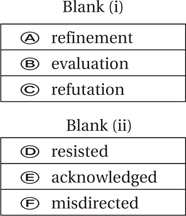
12. A rigid and conventional thinker, he lacked both the (i) ________ to adapt to changing conditions and the (ii) ________ to be innovative.
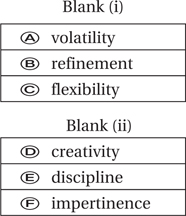
13. Perugino’s initial fame brought him considerable wealth and prestige, if not (i) ________ glory: some years after having been lauded as the most famous artist in Italy, his reputation having suffered a decline, Perugino was (ii) ________ by the acerbic Michelangelo as an artistic (iii) _________.
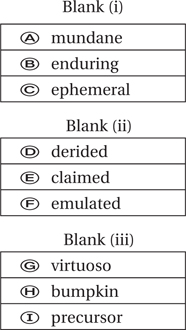
14. Rather than portraying Joseph II as a radical reformer whose reign was strikingly (i) ________, the play Amadeus depicts him as (ii) ________ thinker, too wedded to orthodox theories of musical composition to appreciate an artist of Mozart’s genius.
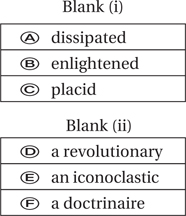
15. Some critics maintain that fixed poetic forms, which require a specific number of lines and syllables, invite and may even (i) _______ wordiness; when no such (ii) ________ exists, the poet can easily spot and (iii) ________ superfluities.

16. University training enables a graduate to see things as they are, to go right to the point, to disentangle a twisted _________ of thought.

Directions: Questions 17 through 20 are based on the content of the following passages. Read the passage and then determine the best answer choice for each question. Base your choice on what the passage states directly or implies, not on any information you may have gained elsewhere.
For each of Questions 17–20, select one answer choice unless otherwise instructed.
QUESTIONS 17–19 ARE BASED ON THE FOLLOWING PASSAGE.
As the works of dozens of women
writers have been rescued from what
E. P. Thompson calls “the enormous
Line condescension of posterity,” and considered
(5) in relation to each other, the lost continent
of the female tradition has risen like Atlantis
from the sea of English literature. It is now
becoming clear that, contrary to Mill’s
theory, women have had a literature of
(10) their own all along. The woman novelist,
according to Vineta Colby, was “really
neither single nor anomalous,” but she was
also more than a “register and spokesman for
her age.” She was part of a tradition that had
(15) its origins before her age, and has carried on
through our own.
Many literary historians have begun to
reinterpret and revise the study of women
writers. Ellen Moers sees women’s literature
(20) as an international movement, “apart from,
but hardly subordinate to the mainstream:
an undercurrent, rapid and powerful. This
‘movement’ began in the late eighteenth
century, was multinational, and produced
(25) some of the greatest literary works of two
centuries, as well as most of the lucrative
pot-boilers.” Patricia Meyer Spacks, in The
Female Imagination, finds that “for readily
discernible historical reasons women have
(30) characteristically concerned themselves
with matters more or less peripheral to male
concerns, or at least slightly skewed from
them. The differences between traditional
female preoccupations and roles and male
(35) ones make a difference in female writing.”
Many other critics are beginning to agree that
when we look at women writers collectively
we can see an imaginative continuum, the
recurrence of certain patterns, themes,
(40) problems, and images from generation to
generation.
17. In the second paragraph of the passage the author’s attitude toward the literary historians cited can best be described as one of
 irony
irony
 ambivalence
ambivalence
 disparagement
disparagement
 receptiveness
receptiveness
 awe
awe
Directions: For the following question, consider each of the choices separately and select all that apply.
18. The passage supplies information for answering which of the following questions?
 Does the author believe the female literary tradition to be richer in depth than its masculine counterpart?
Does the author believe the female literary tradition to be richer in depth than its masculine counterpart?
 Which literary historian maintains that the female literary tradition transcends national boundaries?
Which literary historian maintains that the female literary tradition transcends national boundaries?
 Does Moers share Mill’s concern over the ephemeral nature of female literary renown?
Does Moers share Mill’s concern over the ephemeral nature of female literary renown?
 What patterns, themes, images, and problems recur sufficiently in the work of women writers to belong to the female imaginative continuum?
What patterns, themes, images, and problems recur sufficiently in the work of women writers to belong to the female imaginative continuum?
 Did Mill acknowledge the existence of a separate female literary tradition?
Did Mill acknowledge the existence of a separate female literary tradition?
19. In the first paragraph, the author fails to make use of the technique of
 extended metaphor
extended metaphor
 numeration and classification
numeration and classification
 classical allusion
classical allusion
 direct quotation
direct quotation
 comparison and contrast
comparison and contrast
Directions: For the following question, consider each of the choices separately and select all that apply.
QUESTION 20 IS BASED ON THE FOLLOWING PASSAGE.
In 1798 Thomas Malthus wrote “An
Essay on the Principle of Population,” in
which he postulates that food supply never
Line can keep pace with the rate of increase in
(5) human population. Increase the supply of
food, Malthus argues, and population will
rise to meet this increase. This, he asserts,
means that the race between population
and resources can never be truly won by
(10) any sociocultural system. Therefore, some
measure of social inequality is inevitable in
all human societies.
20. Which of the following statements, if true, would tend to undermine Malthus’s argument?
 The rate of population increase has begun to decline in Northern Europe, but the food supply has not diminished.
The rate of population increase has begun to decline in Northern Europe, but the food supply has not diminished.
 In many nations, the increase in human population has far outstripped the food-producing capacity.
In many nations, the increase in human population has far outstripped the food-producing capacity.
 Human population growth may be limited by the use of contraception.
Human population growth may be limited by the use of contraception.
 For many ethnic and religious groups, artificial control of conception is morally unacceptable.
For many ethnic and religious groups, artificial control of conception is morally unacceptable.
SECTION 3 QUANTITATIVE ABILITY
TIME: 35 MINUTES—20 QUESTIONS
Directions: In each of Questions 1–8, there are two quantities—Quantity A and Quantity B. You are to compare those quantities, taking into consideration any additional information given. The correct answer to such a question is
 if Quantity A is greater;
if Quantity A is greater;
 if Quantity B is greater;
if Quantity B is greater;
 if the two quantities are equal;
if the two quantities are equal;
 if it is impossible to determine which quantity is greater.
if it is impossible to determine which quantity is greater.
Note: The given information, if any, is always centered above the two quantities. In any question, if a symbol or letter appears more than once, it represents the same thing each time.
1.

2.
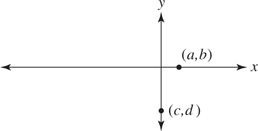

3.

4.
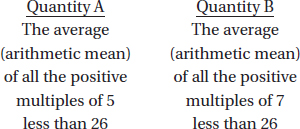
5.
c and d are positive


6.
A number is a palindrome if it reads exactly the same from right to left as it does from left to right. For example, 959 and 24742 are palindromes.
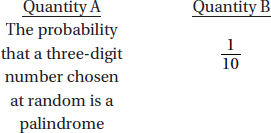
7.
Jack and Jill each bought the same TV set using a 10% off coupon. Jack’s cashier took 10% off the price and then added 8.5% sales tax. Jill’s cashier first added the tax and then took 10% off the total price.

8.


Directions: Questions 9–20 have three different formats. Unless a question has its own directions that specifically state otherwise, each question has five answer choices, exactly one of which is correct.
9. If it is now June, what month will it be 400 months from now?
 January
January
 April
April
 June
June
 October
October
 December
December
Directions: The answer to the following question is a fraction. Enter the numerator in the upper box and the denominator in the lower box.
10. If  of the members of the school chorus are boys, what is the ratio of girls to boys in the chorus?
of the members of the school chorus are boys, what is the ratio of girls to boys in the chorus?

Directions: For the following question, enter your answer in the box.
11. What is the volume of a cube whose total surface area is 54?

12. If A is 25 kilometers east of B, which is 12 kilometers south of C, which is 9 kilometers west of D, how far is it, in kilometers, from A to D?
 20
20






 71
71
Directions: For the following question, consider each of the choices separately and select all that apply.
13. The math scores of all the students who took the SAT in January 2015 formed a normal distribution with a mean of 500 and a standard deviation of 100. Which of the following statements must be true?
Indicate all such statements.
 Fewer than 4% of the students scored above 700.
Fewer than 4% of the students scored above 700.
 More students scored between 500 and 550 than between 600 and 700.
More students scored between 500 and 550 than between 600 and 700.
 More than 80% of the students scored above 400.
More than 80% of the students scored above 400.
 If a student is chosen at random, the probability that his or her math score is less than 600 is greater than
If a student is chosen at random, the probability that his or her math score is less than 600 is greater than  .
.
QUESTIONS 14–16 REFER TO THE FOLLOWING GRAPHS.
Total enrollment in higher education institutions, by control and type of institution: Fall 1972–95

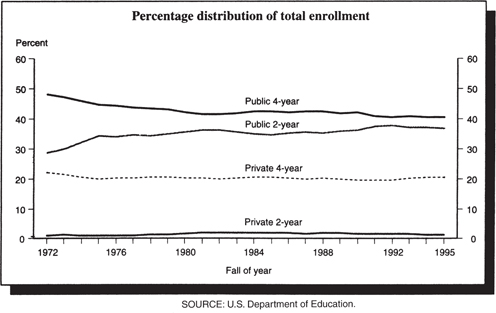
14. In 1995 the number of students enrolled in public institutions of higher education was approximately how many times the number of students enrolled in private institutions of higher education?
 2
2
 2.5
2.5
 3
3
 3.5
3.5
 4
4
15. If the total enrollment in institutions of higher education in 1972 was 5,000,000, approximately how many students were enrolled in private 4-year institutions in 1995?
 1,000,000
1,000,000
 1,100,000
1,100,000
 1,250,000
1,250,000
 1,500,000
1,500,000
 1,650,000
1,650,000
Directions: For the following question, consider each of the choices separately and select all that apply.
16. Based on the information in the two graphs, which of the following statements are true?
Indicate all such statements.
 The number of students enrolled in private 2-year institutions was approximately the same in 1981 and 1987.
The number of students enrolled in private 2-year institutions was approximately the same in 1981 and 1987.
 The percentage of students enrolled in private 2-year institutions was approximately the same in 1981 and 1987.
The percentage of students enrolled in private 2-year institutions was approximately the same in 1981 and 1987.
 From 1972 to 1995, the percentage of college students who were enrolled in 2-year institutions rose by more than 25%.
From 1972 to 1995, the percentage of college students who were enrolled in 2-year institutions rose by more than 25%.
17. Which of the following expresses the area of a circle in terms of C, its circumference?










Directions: For the following question, consider each of the choices separately and select all that apply.
18. If the lengths of two of the sides of a triangle are 9 and 10, which of the following could be the length of the third side?
Indicate all such lengths.
 1
1
 11
11
 21
21
19. If p pencils cost c cents at the same rate, how many pencils can be bought for d dollars?
 cdp
cdp
 100 cdp
100 cdp






20. If 3 children are chosen at random from a group of 5 boys and 5 girls, what is the probability that the 3 children chosen are all boys?










SECTION 4 VERBAL REASONING
TIME: 30 MINUTES—20 QUESTIONS
Directions: For each of the following sentences, select the two answers of the six choices given that, when substituted in the sentence, both logically complete the sentence as a whole and create sentences that are equivalent to one another in meaning.
1. From papayas in Hawaii to canola in Canada, the spread of pollen or seeds from genetically engineered plants is evolving from ________ scientific worry into a significant practical problem.
 a toxic
a toxic
 a theoretical
a theoretical
 a radical
a radical
 an abstract
an abstract
 an overblown
an overblown
 an analogous
an analogous
2. When facts are __________ and data hard to come by, even scientists occasionally throw aside the professional pretense of objectivity and tear into each other with shameless appeals to authority and arguments that are unabashedly ad hominem.
 elusive
elusive
 established
established
 demonstrable
demonstrable
 ineluctable
ineluctable
 uncertain
uncertain
 relevant
relevant
3. You may wonder how the expert on fossil remains is able to trace descent through teeth, which seem __________ pegs upon which to hang whole ancestries.
 novel
novel
 reliable
reliable
 flimsy
flimsy
 specious
specious
 inadequate
inadequate
 academic
academic
4. During the military takeover, the constitution was not abolished, but some of its clauses temporarily were ________ as the armed forces took over the administration.
 suspended
suspended
 notarized
notarized
 under construction
under construction
 put in abeyance
put in abeyance
 left undefined
left undefined
 widely promulgated
widely promulgated
5. Woolf __________ conventional notions of truth: in her words, one cannot receive from any lecture “a nugget of pure truth” to wrap up between the pages of one’s notebook and keep on the mantelpiece forever.
 anticipates
anticipates
 articulates
articulates
 makes light of
makes light of
 mocks
mocks
 pays heed to
pays heed to
 puts up with
puts up with
Directions: The next questions are based on the content of the following passage. Read the passage and then determine the best answer choice for each question. Base your choice on what this passage states directly or implies, not on any information you may have gained elsewhere.
For each of Questions 6–10, select one answer choice unless otherwise instructed.
QUESTION 6 IS BASED ON THE FOLLOWING PASSAGE.
Contemporary literary scholars have come
to discard the once-conventional image of
English theater in the time of Elizabeth I as an
Line anomalous literary wonder, a sudden flower-
(5) ing of creativity rooted not in the dramatic
traditions of England but the theater of an-
cient Greece and Rome. While acknowledging
the debt of the Elizabethan playwrights to the
dramas of Terence, Plautus, and Seneca, and
(10) to the Poetics of Aristotle, the majority of the-
ater scholars today regard Elizabethan drama
as being organically related to traditional
English drama, above all to the medieval
cycles of mystery and morality plays.
Directions: For the following question, consider each of the choices separately and select all that apply.
6. Which of the following is NOT consistent with the passage above?
 Theater historians have significantly altered their views of the origins of Elizabethan drama.
Theater historians have significantly altered their views of the origins of Elizabethan drama.
 England had a native dramatic tradition antedating the Elizabethan era.
England had a native dramatic tradition antedating the Elizabethan era.
 Although Elizabethan drama deals with English subject matter, it derives its form and method solely from classical Greek and Roman theater.
Although Elizabethan drama deals with English subject matter, it derives its form and method solely from classical Greek and Roman theater.
 Once envisioned as a historical and literary anomaly, Elizabethan drama now is interpreted as part of a historical continuum.
Once envisioned as a historical and literary anomaly, Elizabethan drama now is interpreted as part of a historical continuum.
 Modern theater scholars view Elizabethan drama as a direct offshoot of Greek and Roman dramatic traditions.
Modern theater scholars view Elizabethan drama as a direct offshoot of Greek and Roman dramatic traditions.
QUESTION 7 IS BASED ON THE FOLLOWING PASSAGE.
The current trend toward specialization
in nearly all occupational groups is exactly
the opposite of what the educational system
Line needs. World problems today are so diverse,
(5) complex, and interrelated that only the
generalist stands a chance of understanding
the broad picture. Unless our schools stress
a truly broad, liberal education, the world
will crumble around us as we each expertly
(10) perform our own narrow function.
7. Which of the following statements, if true, would not weaken the conclusion drawn above?
 Many of the world’s problems can be solved only by highly specialized experts working on specific problems.
Many of the world’s problems can be solved only by highly specialized experts working on specific problems.
 Relatively few generalists are needed to coordinate the work of the many specialists.
Relatively few generalists are needed to coordinate the work of the many specialists.
 Specialization does not necessarily entail losing the ability to see the broad picture.
Specialization does not necessarily entail losing the ability to see the broad picture.
 Increasingly complex problems require a growing level of technical expertise that can be acquired only through specialization.
Increasingly complex problems require a growing level of technical expertise that can be acquired only through specialization.
 Even the traditional liberal education is becoming more highly specialized today.
Even the traditional liberal education is becoming more highly specialized today.
QUESTIONS 8–10 ARE BASED ON THE FOLLOWING PASSAGE.
Given the persistent and intransigent
nature of the American race system, which
proved quite impervious to black attacks,
Line Du Bois in his speeches and writings moved
(5) from one proposed solution to another,
and the salience of various parts of his
philosophy changed as his perceptions of
the needs and strategies of black America
shifted over time. Aloof and autonomous
(10) in his personality, Du Bois did not hesitate
to depart markedly from whatever was the
current mainstream of black thinking when
he perceived that the conventional wisdom
being enunciated by black spokesmen was
(15) proving inadequate to the task of advancing
the race. His willingness to seek different
solutions often placed him well in advance of
his contemporaries, and this, combined with
a strong-willed, even arrogant personality
(20) made his career as a black leader essentially a
series of stormy conflicts.
Thus Du Bois first achieved his role as
a major black leader in the controversy
that arose over the program of Booker
(25) T. Washington, the most prominent and
influential black leader at the opening of
the twentieth century. Amidst the wave of
lynchings, disfranchisement, and segregation
laws, Washington, seeking the good will
(30) of powerful whites, taught blacks not to
protest against discrimination, but to elevate
themselves through industrial education,
hard work, and property accumulation; then,
they would ultimately obtain recognition of
(35) their citizenship rights. At first Du Bois agreed
with this gradualist strategy, but in 1903 with
the publication of his most influential book,
Souls of Black Folk, he became the chief
leader of the onslaught against Washington
(40) that polarized the black community into two
wings—the “conservative” supporters of
Washington and his “radical” critics.
8. Which of the following statements about W. E. B. Du Bois does the passage best support?
 He sacrificed the proven strategies of earlier black leaders to his craving for political novelty.
He sacrificed the proven strategies of earlier black leaders to his craving for political novelty.
 Preferring conflict to harmony, he followed a disruptive course that alienated him from the bulk of his followers.
Preferring conflict to harmony, he followed a disruptive course that alienated him from the bulk of his followers.
 He proved unable to change with the times in mounting fresh attacks against white racism.
He proved unable to change with the times in mounting fresh attacks against white racism.
 He relied on the fundamental benevolence of the white population for the eventual success of his movement.
He relied on the fundamental benevolence of the white population for the eventual success of his movement.
 Once an adherent of Washington’s policies, he ultimately lost patience with them for their inefficacy.
Once an adherent of Washington’s policies, he ultimately lost patience with them for their inefficacy.
9. It can be inferred that Booker T. Washington in comparison with W. E. B. Du Bois could not be described as
 submissive to the majority
submissive to the majority
 concerned with financial success
concerned with financial success
 versatile in adopting strategies
versatile in adopting strategies
 traditional in preaching industry
traditional in preaching industry
 respectful of authority
respectful of authority
10. The author’s attitude toward Du Bois’s departure from conventional black policies can best be described as
 skeptical
skeptical
 derisive
derisive
 shocked
shocked
 approving
approving
 resigned
resigned
Directions: Each of the following sentences or groups of sentences contains one, two, or three blanks. These blanks signify that a word or set of words has been left out. Below each sentence are columns of words or sets of words. For each blank, pick the one word or set of words from the corresponding column that best completes the text.
11. As any visitor to Claude Monet’s final home at Giverny can ________, Japanese prints were the artist’s passion: his home overflows with works by Hiroshige, Utamaro, and other Japanese masters.
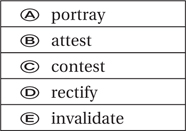
12. Breaking with established musical traditions, Stravinsky was (i) ________ composer whose (ii) ________ works infuriated the traditionalists of his day.
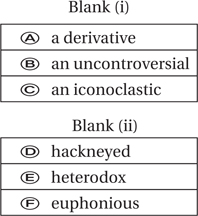
13. While the disease is in (i)_________ state it is almost impossible to determine its existence by (ii) __________.
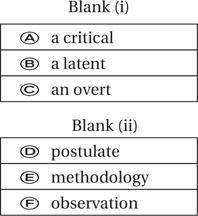
14. The paleontologist’s (i) _______ orthodoxy meant that the evidence he had so painstakingly gathered would inevitably be (ii) ________ by his more conventional colleagues.
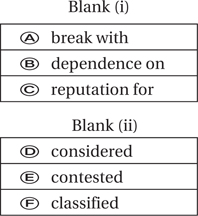
15. An essential purpose of the criminal justice system is to enable purgation to take place; that is, to provide a (i) _________ by which a community expresses its collective (ii) ___________ the transgression of the criminal.

16. In a classic example of scholarly (i) _________, the poet and scholar A. E. Housman once assailed a German rival for relying on manuscripts “as a drunkard relies on lampposts, for support rather than (ii) ________.”
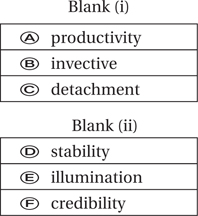
Directions: The next questions are based on the content of the following passage. Read the passage and then determine the best answer choice for each question. Base your choice on what this passage states directly or implies, not on any information you may have gained elsewhere.
For each of Questions 17–20, select one answer choice unless otherwise instructed.
QUESTION 17 IS BASED ON THE FOLLOWING PASSAGE.
Exquisitely adapted for life in one of
Earth’s harshest environments, polar bears
can survive for 20 years or more on the
Line Arctic Circle’s glacial ice. At home in a waste
(5) where temperatures reach minus 50 degrees
Fahrenheit, these largest members of the
bear family are a striking example of natural
selection at work. With two layers of fur over
a subcutaneous layer of blubber, polar bears
(10) are well adapted to resist heat loss. Their
broad, snowshoe-like paws and sharp, curved
claws enable them to traverse the ice with
ease. Formidable hunters, these monarchs
of the icy waste even possess the capacity to
(15) scent prey from a distance of 20 miles.
17. In the context of the passage’s final sentence, “capacity” most nearly means
 faculty
faculty
 stature
stature
 dimensions
dimensions
 spaciousness
spaciousness
 intelligence
intelligence
QUESTIONS 18–20 ARE BASED ON THE FOLLOWING PASSAGE.
At night, schools of prey and predators
are almost always spectacularly illuminated
by the bioluminescence produced by the
Line microscopic and larger plankton. The reason
(5) for the ubiquitous production of light by
the microorganisms of the sea remains
obscure, and suggested explanations are
controversial. It has been suggested that
light is a kind of inadvertent by-product of
(10) life in transparent organisms. It has also
been hypothesized that the emission of
light on disturbance is advantageous to the
plankton in making the predators of the
plankton conspicuous to their predators!
(15) Unquestionably, it does act this way. Indeed,
some fisheries base the detection of their prey
on the bioluminescence that the fish excite.
It is difficult, however, to defend the thesis
that this effect was the direct factor in the
(20) original development of bioluminescence,
since the effect was of no advantage to
the individual microorganism that first
developed it. Perhaps the luminescence of
a microorganism also discourages attack
(25) by light-avoiding predators and is of initial
survival benefit to the individual. As it then
becomes general in the population, the effect
of revealing plankton predators to their
predators would also become important.
18. The primary topic of the passage is which of the following?
 The origin of bioluminescence in plankton predators
The origin of bioluminescence in plankton predators
 The disadvantages of bioluminescence in microorganisms
The disadvantages of bioluminescence in microorganisms
 The varieties of marine bioluminescent life forms
The varieties of marine bioluminescent life forms
 Symbiotic relationships between predators and their prey
Symbiotic relationships between predators and their prey
 Hypotheses on the causes of bioluminescence in plankton
Hypotheses on the causes of bioluminescence in plankton
19. The author mentions the activities of fisheries in order to provide an example of
 how ubiquitous the phenomenon of bioluminescence is coastally
how ubiquitous the phenomenon of bioluminescence is coastally
 how predators do make use of bioluminescence in locating their prey
how predators do make use of bioluminescence in locating their prey
 how human intervention imperils bioluminescent microorganisms
how human intervention imperils bioluminescent microorganisms
 how nocturnal fishing expeditions are becoming more and more widespread
how nocturnal fishing expeditions are becoming more and more widespread
 how limited bioluminescence is as a source of light for human use
how limited bioluminescence is as a source of light for human use
20. The passage provides an answer to which of the following questions?
 What is the explanation for the phenomenon of bioluminescence in marine life?
What is the explanation for the phenomenon of bioluminescence in marine life?
 Does the phenomenon of plankton bioluminescence have any practical applications?
Does the phenomenon of plankton bioluminescence have any practical applications?
 Why do only certain specimens of marine life exhibit the phenomenon of bioluminescence?
Why do only certain specimens of marine life exhibit the phenomenon of bioluminescence?
 How does underwater bioluminescence differ from atmospheric bioluminescence?
How does underwater bioluminescence differ from atmospheric bioluminescence?
 What are the steps that take place as an individual microorganism becomes bioluminescent?
What are the steps that take place as an individual microorganism becomes bioluminescent?
SECTION 5 QUANTITATIVE ABILITY
TIME: 35 MINUTES—20 QUESTIONS
Directions: In each of Questions 1–7, there are two quantities—Quantity A and Quantity B. You are to compare those quantities, taking into consideration any additional information given. The correct answer to such a question is
 if Quantity A is greater;
if Quantity A is greater;
 if Quantity B is greater;
if Quantity B is greater;
 if the two quantities are equal;
if the two quantities are equal;
 if it is impossible to determine which quantity is greater.
if it is impossible to determine which quantity is greater.
Note: The given information, if any, is always centered above the two quantities. In any question, if a symbol or letter appears more than once, it represents the same thing each time.
1.

2.
n is an odd positive integer 700 < n < 800

3.
x < y

4.


5.
0 < a < b

6.
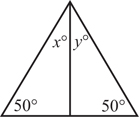

7.
Line  passes through
passes through

Line m is perpendicular to line  .
.

Directions: Questions 8–20 have three different formats. Unless a question has its own directions that specifically state otherwise, each question has five answer choices, exactly one of which is correct.
8. In the figure below, what is the average (arithmetic mean) of the measures of the five angles?
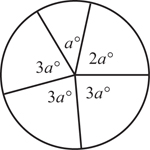
 36
36
 45
45
 60
60
 72
72
 90
90
9. Camille’s average on her 6 math tests this marking period is 75. Fortunately for Camille, her teacher drops each student’s lowest grade, and this raises her average to 85. What was her lowest grade?
 20
20
 25
25
 30
30
 40
40
 50
50
Directions: For Questions 10 and 11, consider each of the choices separately and select all that apply.
10. If the area of a rectangle is 40, which of the following could be the perimeter of the rectangle?
Indicate all such areas.
 20
20
 40
40
 200
200
 400
400
 2,000
2,000
 4,000
4,000
11. Which of the following is an equation of a line that is perpendicular to the line whose equation is 2x + 3y = 4?
Indicate all such equations.
 3x + 2y = 4
3x + 2y = 4
 3x – 2y = 4
3x – 2y = 4
 2x – 3y = 4
2x – 3y = 4
 4 – 3x = –2y
4 – 3x = –2y
 4 + 2x = 3y
4 + 2x = 3y

12. In the figure above, the diameter of the circle is 20 and the area of the shaded region is 80π. What is the value of a + b + c + d?
 144
144
 216
216
 240
240
 270
270
 288
288
Directions: The answer to the following question is a fraction. Enter the numerator in the upper box and the denominator in the lower box.
13. Each integer from 1 to 50 whose units digit is a 3 is written on a slip of paper and placed in a box. If two slips of paper are drawn at random, what is the probability that both the numbers picked are prime?

QUESTIONS 14–16 REFER TO THE FOLLOWING GRAPH.
Motor Vehicle Theft in the U.S. Percent Change from 1994 to 1998
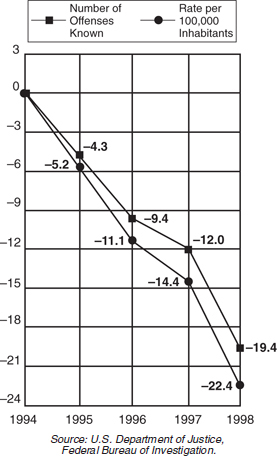
14. If 1,000,000 vehicles were stolen in 1994, how many were stolen in 1996?
 889,000
889,000
 906,000
906,000
 940,000
940,000
 1,094,000
1,094,000
 1,100,000
1,100,000
15. By what percent did the number of vehicles stolen decrease from 1997 to 1998?
 7.4%
7.4%
 8.0%
8.0%
 8.4%
8.4%
 12.0%
12.0%
 19.4%
19.4%
16. To the nearest percent, by what percent did the population of the United States increase from 1994 to 1998?
 1%
1%
 2%
2%
 3%
3%
 4%
4%
 5%
5%
Directions: For the following question enter your answer in the box.
17. If the average (arithmetic mean) of v, w, x, y, and z is 12.3, and the average of v and w is 45.6, what is the average of x, y, and z?

18. At Tyler High School, there are twice as many girls than boys on the yearbook staff. At one staff meeting, the percentage of girls attending was twice the percentage of boys. What percent of those attending were boys?
 20
20
 25
25
 30
30
 33
33
 50
50
Directions: For the following question enter your answer in the box.
19. If four boys can shovel a driveway in two hours, how many minutes would it take five boys to shovel that driveway? (Assume that each boy works at the same rate.)

20. In 1950 Roberto was four times as old as Juan. In 1955, Roberto was three times as old as Juan. How old was Roberto when Juan was born?
 5
5
 10
10
 20
20
 30
30
 40
40
ANSWER KEY
Section 1—Analytical Writing
The Analytical Writing sections are scored holistically, in accordance with the following guidelines.
First, estimate your score on the Issue Essay by using the following rubric.
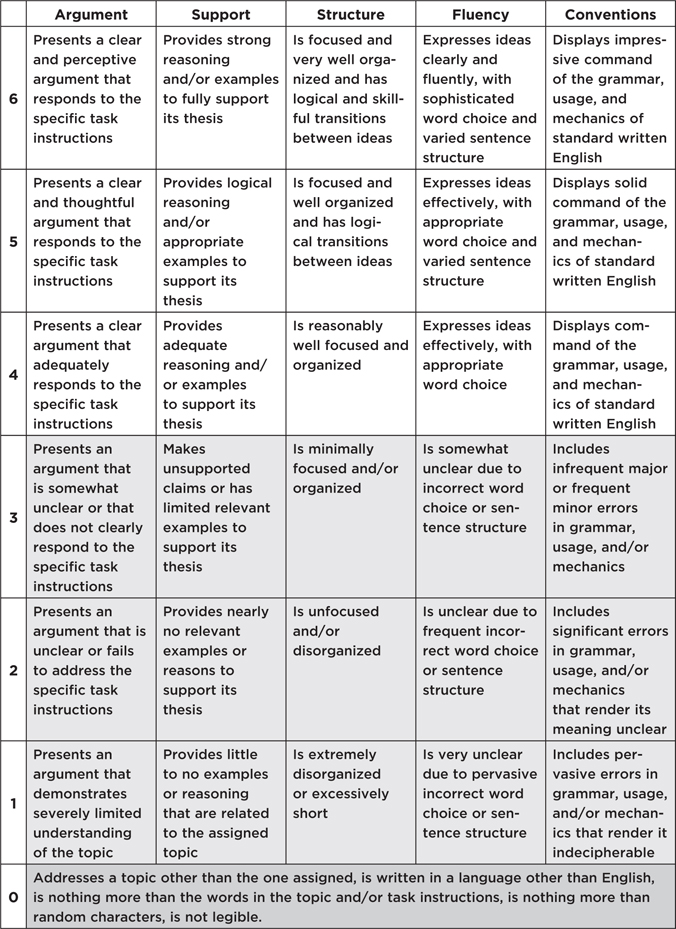
As you examine the rubric you will notice that all of the scores below four are shaded gray. The reason for this is that ETS, the maker of the GRE, states that essays scoring below four display one or more of the characteristics listed in the shaded area. In other words, if your essay displays even one characteristic listed in the shaded area, that low score will determine your overall score. If all of your essay’s characteristics are found in the boxes above the shaded area, your score should be the average of the five scores (for argument, support, structure, fluency, and writing conventions).
SCORING THE ISSUE ESSAY
Using the Issue Essay rubric, check the box in each column that best describes your work. If each of the boxes you have checked is above the shaded area, add those five scores together and calculate their average.
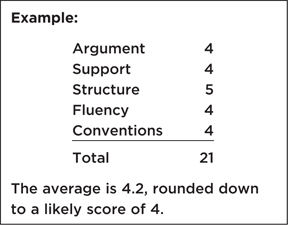
If, however, any of your scores fall into the shaded area of the rubric, the lowest score marked will be your final score.
Next, estimate your score on the Argument Essay by using the following rubric.

SCORING THE ARGUMENT ESSAY
Using the Argument Essay rubric, check the box in each column that best describes your work. If each of the boxes you have checked is above the shaded area, add those five scores together and calculate their average.
CALCULATING YOUR OVERALL SCORE
To determine your overall Analytical Writing score, add the scores for both essays (Issue and Argument) together and divide by 2. The overall score is given in half-point increments, so you should round up to the nearest half point when calculating this score. As an example, if you earn a score of 5 on the Issue Essay and a score of 4.5 on the Argument Essay, your overall Analytical Writing score will be 4.75, rounded up to 5.
Note: The letters in brackets following the Quantitative Ability answers in Sections 3 and 5 refer to the sections of Chapter 12 in which you can find the information you need to answer the questions. For example, 12. A [J] means that the answer to question 12 is A, and that the solution requires information found in Section 12-J: Triangles. Also, 14. D [11] means that the answer to question 14 is D and is based on information in Chapter 11: Data Interpretation.
 Coverage of each of the elements in the task instructions
Coverage of each of the elements in the task instructions Analysis of the statement’s implications
Analysis of the statement’s implications Organization and articulation of your ideas
Organization and articulation of your ideas Use of relevant examples and arguments to support your case
Use of relevant examples and arguments to support your case Handling of the mechanics, grammar, and usage of standard written English
Handling of the mechanics, grammar, and usage of standard written English intimidate
intimidate estrange
estrange avenge
avenge arbitrate
arbitrate commiserate
commiserate disaffect
disaffect Black writers played only a minor part in protesting the injustices of the period.
Black writers played only a minor part in protesting the injustices of the period. Left to itself, the system was certain to function efficiently.
Left to itself, the system was certain to function efficiently. Black writers in general were not opposed to the system as such.
Black writers in general were not opposed to the system as such. In order for the system to operate efficiently, blacks must seize the reins of power in America.
In order for the system to operate efficiently, blacks must seize the reins of power in America. Black writers were too caught up in aesthetic questions to identify the true nature of the conflict.
Black writers were too caught up in aesthetic questions to identify the true nature of the conflict.
















 of the members of the school chorus are boys, what is the ratio of girls to boys in the chorus?
of the members of the school chorus are boys, what is the ratio of girls to boys in the chorus?




 .
.




























 passes through
passes through








